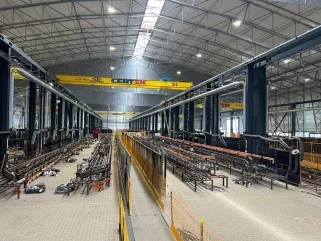
Currently, 1,500 tons of reinforcement are being produced weekly.
A substantial amount of steel is required to build the world’s longest immersed tunnel, and the task of bending, cutting, and welding the thousands of tons of steel is one of the most critical tasks in the project.
The tunnel elements are cast around massive cages of reinforcement steel and as all production lines in the factory have come into operation, the need for steel has increased significantly.
The work is so critical for the construction that last year it was decided to erect a separate factory hall on the construction site to supply steel to the element factory and portal construction.
The hall, called the Panel Factory, covers about 13,000m² of the construction site and employs around 120 workers working in two shifts. The steel is cut to the sizes needed, reducing waste and strengthening the supply security for the project by producing steel grids to size and on demand.
Most of the welding is done by the two robots, which handle over 70% of the production. The robots are fed by a magnetic crane that can lift up to five tons of steel at a time. The steel comes in rods up to 15m long and 32mm in diameter.
The robotic welding machine is a prototype made by the Spanish company DCM-Wire. Normally, these machines are used to make thin panels for fences; the Fehmarn project is the first place in the world where robotic welding machines are used to weld reinforcement steel of this thickness.
The first 217m-long tunnel element was cast in May this year. It consists of nine segments, each 24m long. The tunnel requires 79 elements of this type, another 10 special elements with space for the technical installations.







